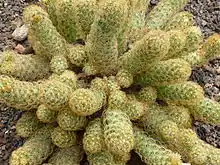Cactoideae
The Cactoideae are the largest subfamily of the cactus family, Cactaceae. Around 80% of cactus species belong to this subfamily.[1] As of August 2018, the internal classification of the family Cactaceae remained uncertain and subject to change. A classification incorporating many of the insights from the molecular studies was produced by Nyffeler and Eggli in 2010.[2] Various revisions have been published since, e.g. to the tribe Hylocereeae and the tribe Echinocereeae.[3] Classifications remained uncertain as of March 2019.
| Cactoideae | |
|---|---|
 | |
| Mammillaria elongata | |
| Scientific classification | |
| Kingdom: | Plantae |
| Clade: | Tracheophytes |
| Clade: | Angiosperms |
| Clade: | Eudicots |
| Order: | Caryophyllales |
| Family: | Cactaceae |
| Subfamily: | Cactoideae Eaton |
| Tribes or clades | |
Tribes and genera
- Blossfeldieae
- Fraileeae
- Cereeae
- Cereinae
- Rebutiinae
- Aylostera – Browningia – Gymnocalycium – Lasiocereus – Rebutia – Stetsonia – Uebelmannia
- Trichocereinae
- Acanthocalycium – Arthrocereus – Borzicactus – Chamaecereus – Cleistocactus – Denmoza – Echinopsis – Espostoa – Haageocereus – Harrisia – Leucostele – Lobivia – Loxanthocereus – Matucana – Mila – Oreocereus – Oroya – Rauhocereus – Reicheocactus – Samaipaticereus – Setiechinopsis – Soehrensia – Trichocereus – Vatricania – Weberbauerocereus – Yungasocereus
- Cacteae
- Acharagma – Ariocarpus – Astrophytum – Aztekium – Coryphantha – Cumarinia – Echinocactus – Echinomastus – Epithelantha – Escobaria – Ferocactus – Geohintonia – Glandulicactus – Homalocephala (see Echinocactus) – Kadenicarpus – Leuchtenbergia – Lophophora – Mammillaria – Obregonia – Ortegocactus – Pediocactus – Pelecyphora – Rapicactus – Sclerocactus – Stenocactus – Strombocactus – Thelocactus – Turbinicarpus
- Echinocereeae
- Armatocereus – (Acanthocereus is placed in Hylocereeae)[3] –Austrocactus – Bergerocactus – Brachycereus – Carnegiea – Cephalocereus – Corryocactus – Echinocereus – Escontria – Jasminocereus – Leptocereus – Lophocereus – Myrtillocactus – Neoraimondia –Pachycereus – Peniocereus – Pfeiffera – Pilosocereus – Polaskia – Stenocereus – Stephanocereus – Strophocactus
- Hylocereeae[3]
- Acanthocereus – Deamia – Disocactus – Epiphyllum – Kimnachia – Pseudorhipsalis – Selenicereus (including Hylocereus) – Weberocereus
- Lymanbensonieae
- Notocacteae
- Copiapoa – Eriosyce – Neowerdermannia – Parodia – Thelocephala – Yavia
- Rhipsalideae
References
- Arthur C. Gibson; Park S. Nobel (11 October 1990). The Cactus Primer. Harvard University Press. p. 23. ISBN 9780674089914.
- Nyffeler, R. & Eggli, U. (2010). "A farewell to dated ideas and concepts: molecular phylogenetics and a revised suprageneric classification of the family Cactaceae". Schumannia. 6: 109–149. doi:10.5167/uzh-43285. S2CID 89650660.
- Korotkova, Nadja; Borsch, Thomas & Arias, Salvador (2017). "A phylogenetic framework for the Hylocereeae (Cactaceae) and implications for the circumscription of the genera". Phytotaxa. 327 (1): 1–46. doi:10.11646/phytotaxa.327.1.1.
This article is issued from Wikipedia. The text is licensed under Creative Commons - Attribution - Sharealike. Additional terms may apply for the media files.